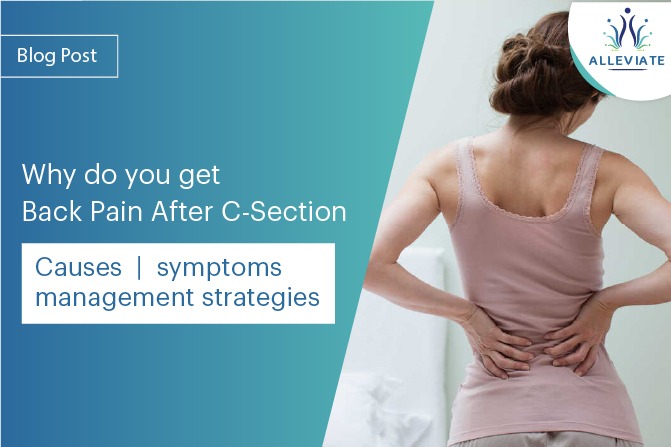Introduction
Experiencing back pain after a Cesarean section (C-section) is not uncommon, and many women may encounter this discomfort during the postpartum period. While the joy of welcoming a new life is unparalleled, the physical toll of childbirth, especially C-sections, can lead to various challenges, including back pain.
Causes of Back Pain After C-Section
Postural Changes : The altered posture during pregnancy and the strain placed on the back during the C-section procedure can contribute to changes in the spine’s alignment.


Abdominal Muscle Weakness : The incision made during a C-section affects the abdominal muscles, leading to weakness. This can result in the lower back compensating for the lack of abdominal support.
Scar Tissue Formation : The formation of scar tissue around the C-section incision may restrict movement and contribute to pain.


- Hormonal Changes : Hormonal fluctuations, particularly the reduction of relaxin after delivery, can affect ligament laxity and contribute to back pain.
Lifting and Carrying : Lifting and carrying the newborn, along with the demands of caring for an infant, can strain the back muscles.
Understanding Ligament Instability and Pelvic/Sacroiliac Joint Pain Causing Back Pain After C -section
- Post-C-Section Ligament Changes : The process of childbirth, especially a C-section, can lead to changes in the ligaments supporting the pelvic and sacroiliac joints. The ligaments may become overstretched or weakened during pregnancy and childbirth.
- Hormonal Influences : Hormonal changes, specifically the hormone relaxin, which increases during pregnancy to facilitate childbirth, can contribute to ligament laxity. However, an abrupt decrease in relaxin levels postpartum may lead to instability.
Impact on Pelvic and Sacroiliac Joints


- Pelvic Girdle Pain (PGP) : Ligament instability can result in Pelvic Girdle Pain (PGP), a condition characterized by discomfort and pain in the pelvic region. This can extend to the sacroiliac joints.
- Sacroiliac Joint Dysfunction : Ligamentous laxity may contribute to sacroiliac joint dysfunction, leading to pain
Back Pain After C-Section: Recognizing the Symptoms
- Lower Back Pain : Persistent ache or discomfort in the lower back region, often centered around the lumbar spine.
- Pelvic Girdle Pain (PGP) : Pain in the pelvic region, including the pubic bone, hips, and sacroiliac joints.
- Radiating Pain : Pain that radiates from the lower back and extends to the buttocks, thighs, or even down to the legs.
- Abdominal Discomfort : Discomfort or pain in the abdominal area, particularly around the C-section scar.
- Difficulty in Movement : Reduced flexibility or difficulty in certain movements, such as standing up, sitting, or walking.
- Muscle Tension and Stiffness : Feeling of muscle tightness and stiffness, especially around the lower back and pelvic area.
How can I reduce back pain after C-section? Effective Management Strategies
- Proper Posture and Body Mechanics : Emphasize maintaining good posture during daily activities to reduce strain on the back.
- Core Strengthening Exercises : Gradual incorporation of postpartum-safe exercises targeting the core muscles to improve stability.
- Physical Therapy : Consultation with a physical therapist for personalized exercises and stretches to address specific post-C-section concerns.
- Scar Tissue Management : Gentle massage or scar tissue mobilization to promote tissue flexibility and reduce adhesions.
- Heat and Cold Therapy : Application of heat or cold packs to alleviate pain and reduce inflammation in the affected areas.
- Pain Management Techniques : Utilizing heat or cold packs, over-the-counter pain relievers (as advised by a healthcare provider), and relaxation techniques.
- Supportive Devices : Consideration of supportive belts or braces to provide additional support to the lower back.
The Role of Prolotherapy
- What is Prolotherapy?
Prolotherapy, or regenerative injection therapy, involves injecting a solution (often containing dextrose) into weakened or damaged ligaments to stimulate the body’s natural healing response. - How Prolotherapy Addresses Instability
Prolotherapy strengthens ligaments and stabilizes joints by promoting the growth of new, healthier tissue. It targets the root cause of instability. - Effectiveness in Post-C-Section Cases
Prolotherapy has shown promising results in addressing ligament instability and relieving chronic back pain, making it an excellent modality for post-C-section patients. - Consideration in Consultation with Healthcare Provider
Before opting for prolotherapy, consultation with a healthcare provider such as Alleviate Pain Clinic is essential to determine its suitability for individual cases.
Normal Back Pain vs Concerning Symptoms
- Normal Post-C-Section Discomfort : Mild to moderate discomfort or pain around the incision site and lower back is common in the initial postpartum weeks.
- Concerning Symptoms that Warrant Medical Attention : If experiencing severe or worsening pain, persistent discomfort, or additional concerning symptoms, it’s crucial to consult a doctor promptly.
When to Seek Immediate medical attention?
- Persistent or Increasing Pain : While some discomfort is expected, persistent or escalating pain, especially beyond the initial recovery weeks, requires medical evaluation.
- Pain Accompanied by Fever : The presence of fever alongside back pain may indicate an infection, necessitating immediate medical attention.
- Swelling, Redness, or Warmth Around the Incision : These signs may suggest infection or inflammation, requiring prompt assessment by a healthcare professional.
- Difficulty in Movement or Walking : If back pain significantly impedes mobility or walking, it’s advisable to seek medical advice for a comprehensive evaluation.
- Numbness or Tingling Sensations : These symptoms may indicate nerve involvement and should be promptly assessed by a healthcare provider.
Conclusion
While some degree of back pain is expected after a C-section, it’s crucial for new mothers to discern between normal postpartum discomfort and symptoms that warrant medical attention. Recognizing the signs early and seeking prompt medical evaluation ensures a proactive approach to managing back pain, promoting a smoother and more comfortable post-C-section recovery. Always consult with healthcare professionals for personalized advice based on individual circumstances.



